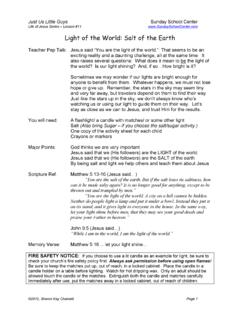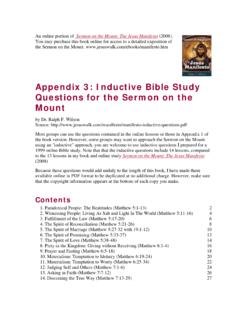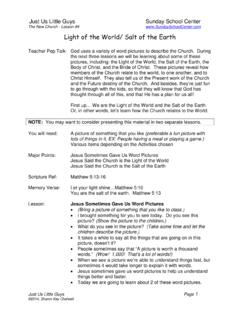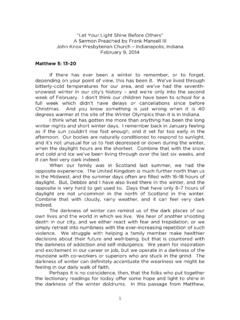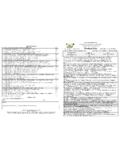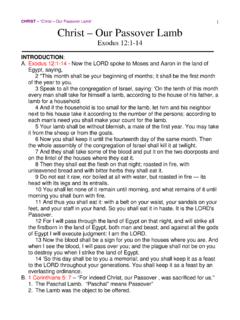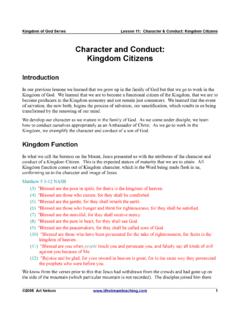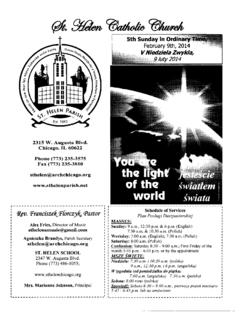Transcription of Wheat and Tares - John Dubler
1 Parable of the Wheat and Tares matthew 13: 24-30; 36-43. This parable of our Lord Jesus appears only in the Gospel of matthew . Even though the Lord Himself clearly explains the parable, notably telling us that the field is the world ( matthew 13: 38), the matter is nonetheless much debated. It is truly amazing how many commentators disregard the Lord's explanation and tell us that the field is the church. But this is not a parable about false saints within the church, it is a parable about evil in the world. It is not a parable which tells us not to perform church discipline (allow both to grow together until the harvest), for there are substantial references elsewhere that tell us what to do with the hidden reefs in [our] love feasts (Jude 12), and the immoral ones among us (1 Corinthians 5:1).
2 Fortunately, for us, an explanation of the parable spoken to the multitudes in matthew 13: 24-30 follows hard on the heels of the Parable of the Mustard Seed and the Leaven. The explanation, found in verses 36-43, is separated from the body of the parable because matthew , preserving for us a sense of his eyewitness testimony, relates the Mustard Seed and the Leaven parables at the place and time they were told by the Lord. Later on, with those additional parables spoken, He left the crowds and went into the house with the disciples following Him. It was in the house, away from the crowds, that the disciples asked for an explanation of the Parable of the Wheat and Tares . How often we wish the original 12 would have asked that He explain them all.
3 Therefore, the body of the parable is spoken to the crowd while the explanation is spoken only to the disciples. Thus, the Lord, of necessity being on His guard when speaking to the crowds, was able to specifically instruct His disciples without casting His pearls before a divided multitude, where both dogs and swine were listening, not with pure hearts, but seeking an opportunity to ensnare Him ( matthew 7:6). Parables veil or conceal the truth. They do not make matters more clear to hearers, as asserted by some. Even the disciples had to ask for an explanation. But why conceal the truth from the sincere seekers who are not among the twelve? The presence of those dogs and swine in the context of the larger crowd, make any other course impossible.
4 Besides, the veil is soon enough lifted when the sincere seeker begins to earnestly inquire of the Lord. The Holy Spirit is our teacher, and He will guide us into all truth (John 16:13). Sincere seekers will not give up until they finally understand, while the casual and insincere will quit the hunt and fade away. 1. The overall Meaning of the Parable. The message is this: Righteous believers and wicked people will exist in the world until the day Jesus returns at the end of the age, and the final harvest takes place. Until that glorious day, we are not to try to separate out the salt and light from the deteriorating body which is the world. We are not to withdraw ourselves to a fortified castle, prepared to fight off the attack of the world, waiting out the return of the Lord.
5 Despite the presence of those nasty evil weeds (people), the crop will mature. Good will not be overcome by evil. The righteous will not be eliminated by the enemy's tactic to sow evil seed in God's field. Also, the source of evil in the world is clearly spelled out in the parable. An enemy has done this.. The elements of the parable. Here are the terms of the Wheat and Tares as defined by our Lord in matthew 13: 36-43. A. Who is the sower? Jesus identifies the sower as Himself in verse 37: The one who sows the good seed is the Son of Man .. Son of Man is commonly understood as a messianic title which Jesus uses, along with Son of David.. B. The field: .. and the field is the world .. (verse 38).
6 As I previously observed, the world does not mean the church. No matter how one might try to apply this parable to those in the church, the text only supports the field is the world. All other interpretations will lead to false applications of other elements of the parable. C. The good seed: .. and as for the good seed, these are the sons of the kingdom .. (verse 38). Whatever good seed there may be, those redeemed souls who acknowledge Jesus as both Savior and Lord of their lives and live their words, such seed is sown by the Son of Man and Him only. The good seed is not sown by Mohamed, Buddha, Confucius or ourselves (by evolving into a more and more perfect existence by our own will).
7 These good seeds sown into the world, meaning they are planted by the Lord in every place upon earth. They sprout up all over the place, from lands under the rule of iron fisted dictatorships to the shores of benevolent democratic republics. D. And as for the Tares : they are the sons of the evil one (verse 38). An examination of verse 41 reveals two synonyms: Stumbling Blocks and Lawless Ones. The Son of Man will send forth his angels and they will gather out of his kingdom all stumbling blocks and those who commit lawlessness .. These people may look like believers, but they are not. Not even the safe haven of the church will protect them when the end comes. And, although they may be hard to distinguish from believers now, in time their true nature will manifest itself, making their identity an easy matter.
8 These are the false prophets of matthew 7:15-20. What should we do about them? Nothing. Let them grow along with us. Their true natures will become as evident as grapes versus thorns and figs versus thistles. E. The enemy who sowed them [the Tares ] is the devil. More about this presently in the exposition section. F. The harvest is the end of the age. The world is not yet ready to be reaped, but someday, and perhaps soon, the Lord will descend from heaven with a shout, with the voice of the archangel and with the trumpet of God .. (1 Thessalonians 4:16). G. The reapers are angels. The angels of Revelation await their command to reap the earth (Revelation 14:14 and following). 2. Exposition of the parable.
9 Matthew13: 24-25 While his men were sleeping his enemy came and sowed Tares among the Wheat and went away. The men were not sleeping because they were lazy, but rather because it was the normal time to sleep. However, the enemy is very clever and full of deceit. He does not approach during the daylight, but lurks in night shadows, steals in to the field and sows the weed seed in stealth and perfidy. He prefers darkness. We are all sons of light and sons of day, we are not of night nor of darkness (1 Thessalonians 5:5). Once the damage has been done, he slips back into the night and disappears. The devil sowed Tares into the field where the good seed were already sown. These Tares represent evil or evil people in the world.
10 The volumes on the source of evil in the world must number in the tens of thousands. In our own time we frequently take note of books which attempt to answer the question, Why do bad things happen to good people? Those with a Biblical perspective on the question will always come back to this: an enemy has done this.. Therefore, we cannot and should not blame God for the fact that Tares are growing alongside Wheat in the world. God is infinite in purity and holiness. He is full of goodness and would never be the one to sow evil into the world. Rather the enemy, Satan, has done this. Wheat and Tares Satan is he who sows evil, discord, disharmony, division and evil followers themselves in to the world.


